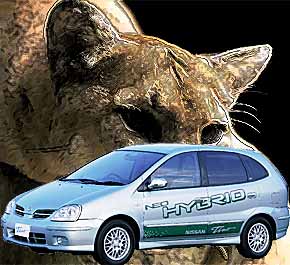|
Nissan
Tino
|
|
The Nissan Tino Hybrid
crossover vehicle was released in 2000 in Japan and sold
over the Internet to 100 or so lucky customers (orders
were filled within a month after the announcement).
The Tino Hybrid uses a
Hitachi three-phase ac synchronous electric motor (23
hp) and a conventional 4-cylinder 1.8L QG18DE DOHC, 16-valve
inline internal combustion engine (100 hp) for reduced
emissions and greater fuel efficiency.
|
The Nissan Tino Hybrid crossover (cross between car and minivan)
uses the NEO hybrid system and a steel-belt-and-pulley continuously
variable transmission (CVT) to achieve 50-percent greater fuel
efficiency and 50-percent less emissions than the standard gasoline-only
Tino automobile. On deceleration, the Tino Hybrid uses its regenerative
braking system to recharge the electrical system.
The Tino Hybrid is a compact 5-seater that uses two inline
lithium-ion battery packs, which are located mid-car underneath
a raised rear floor. As a crossover vehicle, the Tino Hybrid
is a parallel full hybrid type, employing two electric motors,
with the main electric motor doing all the work at low speeds
and being assisted by the gasoline engine as more power is needed.
The Tino Hybrid system is controlled by a main hybrid computer
and five individual control units. These control units manage
the battery, electric motor, engine, engine-propulsion-motor
clutch, and CVT. On its chassis, the Tino Hybrid has electrically
assisted rack and pinion steering, ultra-lightweight aluminum
wheels and low rolling resistance tires.
The Tino Hybrid crossover vehicle has been a modest commercial
experiment for Nissan. Nissan, however, has now turned their
focus to using Toyota's technology, combining power and
fuel efficiency, to bring a new Nissan
Altima Hybrid to market in 2007.
|


